Timothy Walter "Tim" Burton (born August 25, 1958) is an American film director, film producer, writer and artist. He is famous for dark, quirky-themed movies such as Beetlejuice, Edward Scissorhands, The Nightmare Before Christmas, Sleepy Hollow, Corpse Bride and Sweeney Todd: The Demon Barber of Fleet Street, and for blockbusters such as Pee-wee's Big Adventure, Batman, Batman Returns, Planet of the Apes, Charlie and the Chocolate Factory and Alice in Wonderland. He also wrote and illustrated the poetry book The Melancholy Death of Oyster Boy & Other Stories, published in 1997, and a compilation of his drawings, entitled The Art of Tim Burton, was released in 2009.
Burton has directed 14 films as of 2010, and has produced 10 as of 2009. His next films are a film adaptation of soap opera Dark Shadows, which began production in January 2011 and a remake of his short Frankenweenie, which will be released on October 5, 2012.
Burton was born in 1958, in the city of Burbank, California, to Jean Burton (née Erickson), the owner of a cat-themed gift shop, and Bill Burton, a former minor league baseball player. As a young man, Burton would make short films in his backyard on Evergreen Street using crude stop motion animation techniques or shoot them on 8 mm film without sound. (One of his most famous juvenile films is The Island of Doctor Agor, that he made when he was 13 years old.) Burton studied at the Burbank High School. He was a very introspective person, and found his pleasure in painting, drawing and watching movies. His future work would be heavily influenced by the works by Edgar Allan Poe that he read, and the horror and science fiction films he watched, such as Godzilla, the films made by Hammer Film Productions, the works of Ray Harryhausen and Vincent Price.
After graduating from Burbank High School with Jeff Riekenberg, Burton attended the California Institute of the Arts to study character animation. Some of his classmates were John Lasseter, Brad Bird, John Musker and Henry Selick. (In the future, Selick and Burton would work together in The Nightmare Before Christmas and James and the Giant Peach.)
Burton graduated from CalArts in 1979. The success of his short film Stalk of the Celery Monster attracted the attention of the Walt Disney Animation Studios, who offered young Burton an animator's apprenticeship at their studio. He worked as an animator, storyboard artist and conceptual artist in films such as The Fox and the Hound, The Black Cauldron and Tron.
While at Disney in 1982, Burton made his first short, Vincent, a six minute black and white stop motion film based on a poem written by the filmmaker, and depicting a young boy who fantasizes that he is his hero Vincent Price, with Price himself providing narration. The film was produced by Rick Heinrichs, whom Burton had befriended while working in the concept art department at Disney. The film was shown at the Chicago Film Festival and released, alongside the teen drama Tex, for two weeks in one Los Angeles cinema. This was followed by Burton's first live-action production Hansel and Gretel, a Japanese-themed adaptation of the Brothers Grimm fairy tale for the Disney Channel, which climaxes in a kung-fu fight between Hansel and Gretel and the witch. Having aired once at 10:30 pm on Halloween 1983 and promptly shelved, prints of the film are extremely difficult to locate, which contributes to the rumor that this project does not exist. (In 2009, the short went on display in the Museum of Modern Art.)
Burton's next live-action short, Frankenweenie, was released in 1984. It tells the story of a young boy who tries to revive his dog after it is run over by a car. It was filmed in black-and-white. After Frankenweenie was completed, Disney fired Burton, under the pretext of him spending the company's resources on doing a film that would be too dark and scary for children to see.
Pursuing then an opportunity to make a full-length film, he was approached by Griffin Dunne to direct the black comedy film After Hours. However, after Martin Scorsese's project The Last Temptation of Christ was cancelled, he showed an interest on directing it, and Burton bowed out in respect for Scorsese.
Pee-wee's Big Adventure
Not long after, actor Paul Reubens saw Frankenweenie and chose Burton to direct the cinematic spin-off of his popular character Pee-wee Herman. Pee-wee Herman gained mainstream popularity with a successful stage show at the Roxy which was later turned into an HBO special. The film, Pee-wee's Big Adventure (1985), was made on a budget of $8 million and grossed more than $40 million at the box office. Burton, a fan of the eccentric musical group Oingo Boingo, asked songwriter Danny Elfman to provide the music for the film. Since then, Elfman has provided the score for all but five of the films Burton has directed and/or produced, those being Cabin Boy, Ed Wood, James and the Giant Peach, Batman Forever and Sweeney Todd: The Demon Barber of Fleet Street.
Beetlejuice
After directing episodes for the revitalized TV series Alfred Hitchcock Presents and Shelley Duvall's Faerie Tale Theatre, Burton received his next big project: Beetlejuice (1988), a supernatural comedy horror about a young couple forced to cope with life after death, as well as a family of pretentious yuppies invading their treasured New England home including their teenage daughter Lydia (Winona Ryder) whose obsession with death allows her to see them. Starring Alec Baldwin and Geena Davis, and featuring Michael Keaton as the obnoxious bio-exorcist Betelgeuse, the film grossed $80 million on a relatively low budget and won a Best Makeup Design Oscar. It would be converted into a cartoon of the same name, with Burton playing a role as executive producer, that would run for four seasons on ABC and later Fox.
Batman
Burton's ability to produce hits with low budgets impressed studio executives, and he received his first big budget film, Batman. When the film opened in June 1989, it was backed by the biggest marketing and merchandising campaign in film history at the time, and became one of the biggest box office hits of all time, grossing well over US$250 million in the U.S. alone and $400 million worldwide (numbers not adjusted for inflation) and earning critical acclaim for the performances of both Michael Keaton and Jack Nicholson, as well as the film's production aspects, which won the Academy Award for Best Art Direction. The success of the film helped establish Burton as a profitable director, and it also proved to be a huge influence on future superhero films, which eschewed the bright, all-American heroism of Richard Donner's Superman for a grimmer, more realistic look and characters with more psychological depth. It also became a major inspiration for the successful 1990s cartoon Batman: The Animated Series, in as much as the darkness of the picture and its sequel allowed for a darker Batman on television.
Burton claimed that The Killing Joke was a major influence on his film adaptation of Batman:
"I was never a giant comic book fan, but I've always loved the image of Batman and The Joker. The reason I've never been a comic book fan—and I think it started when I was a child—is because I could never tell which box I was supposed to read. I don't know if it was dyslexia or whatever, but that's why I loved The Killing Joke, because for the first time I could tell which one to read. It's my favorite. It's the first comic I've ever loved. And the success of those graphic novels made our ideas more acceptable. I write therefore I am"
Edward Scissorhands
In 1990, Burton co-wrote (with Caroline Thompson) and directed Edward Scissorhands, re-uniting with Winona Ryder from Beetlejuice. His friend Johnny Depp, a teen idol at the end of the 1980s due primarily to his work on the hit TV series 21 Jump Street, was cast in the title role of Edward, who was the creation of an eccentric and old-fashioned inventor (played by Vincent Price in one of his last screen appearances). Edward looked human, but was left with scissors in the place of hands due to the untimely death of his creator. Set in suburbia (the film was shot in Lutz, Florida), the film is largely seen as Burton's autobiography of his own childhood in the suburb of Burbank. Price at one point is said to have remarked, "Tim is Edward." Depp wrote a similar comment in the foreword to Mark Salisbury's book, Burton on Burton, regarding his first meeting with Burton over the casting of the film. Edward is considered Burton's best movie by many critics. Following this collaboration with Burton, Depp starred in Ed Wood, Sleepy Hollow, Charlie and the Chocolate Factory, Corpse Bride, Sweeney Todd: The Demon Barber of Fleet Street and Alice in Wonderland.
In 2004, Matthew Bourne came to Burton with the idea to turn the story of Edward into a ballet. In 2005, the ballet first aired. It has now toured the UK, the U.S., Canada, Australia and parts of Europe.
Batman Returns
The day Warner Brothers had declined to make the more personal Scissorhands even after the success of Batman, Burton finally agreed to direct the sequel for Warner Brothers on the condition that he would be granted total control. The result was Batman Returns which featured Michael Keaton returning as the Dark Knight, and a new triad of villains: Danny DeVito (as the Penguin), Michelle Pfeiffer (as Catwoman) and Christopher Walken as Max Shreck, an evil corporate tycoon and original character created for the film. Darker and considerably more personal than its predecessor, concerns were raised that the film was too scary for children. Audiences were even more uncomfortable at the film's overt sexuality, personified by the sleek, fetish-inspired styling of Catwoman's costume. One critic remarked, "too many villains spoiled the Batman", highlighting Burton's decision to focus the storyline more on the villains instead of Batman. The film also polarized the fanbase, with some loving the darkness and quirkiness, while others felt it was not true to the core aspects of the source material. Burton made many changes to the Penguin which would be applied to the Penguin in both comics and television. While in the comics, he was an ordinary man, Burton created a freak of nature resembling a penguin with webbed, flipper-like fingers, a hooked, beak-like nose, and a penguin-like body. Released in 1992, Batman Returns grossed $282.8 million worldwide, making it another financial success, though not to the extent of its predecessor. This would also be the last Batman film to feature Burton and Keaton as director and lead actor respectively.
The Nightmare Before Christmas
Next, Burton wrote and produced (but did not direct, due to schedule constraints on Batman Returns) The Nightmare Before Christmas (1993), originally meant to be a children's book in rhyme. The film was directed by Henry Selick and written by Michael McDowell and Caroline Thompson, based on Burton's original story, world and characters. The film received positive reviews for the film's stop motion animation, musical score and original storyline and was a box office success, grossing $50 million. Burton collaborated with Selick again for James and the Giant Peach (1996), which Burton co-produced. The movie helped to generate a renewed interest in stop-motion animation.
A deleted scene from The Nightmare Before Christmas features a group of vampires playing hockey on the frozen pond with the decapitated head of Burton. The head was replaced by a jack-o'-lantern in the final version.
Cabin Boy
In 1994, Burton and frequent co-producer Denise Di Novi produced the 1994 fantasy-comedy Cabin Boy, starring comedian Chris Elliott and directed/written by Adam Resnick. Burton was originally supposed to direct the film after seeing Elliott perform on Get a Life, but handed the directing responsibility to Resnick once he was offered Ed Wood. The film was almost entirely panned by critics, even earning Chris Elliott a 1995 Razzie Award for "Worst New Star".
Ed Wood
His next film, Ed Wood (1994), was of a much smaller scale, depicting the life of Ed Wood, a filmmaker sometimes called "the worst director of all time". Starring Johnny Depp in the title role, the film is an homage to the low-budget sci-fi and horror films of Burton's childhood, and handles its comical protagonist and his motley band of collaborators with surprising fondness and sensitivity. Owing to creative squabbles during the making of The Nightmare Before Christmas, Danny Elfman declined to score Ed Wood, and the assignment went to Howard Shore. While a commercial failure at the time of its release, Ed Wood was well received by critics. Martin Landau received an Academy Award in the Best Supporting Actor category for his portrayal of Béla Lugosi. Gene Siskel once said that two flims, Ed Wood and Citizen Kane, be mandatory films to see in film classes.
Batman Forever
Despite his intention to still lead the Batman franchise, Warner Bros. considered Batman Returns too dark and unsafe for children. To attract the young audience, it was decided that Joel Schumacher, who had directed films like The Client, lead the third film, while Burton would only produce it in conjunction with Peter McGregor-Scott. Following this change and the changes made by the new director, Michael Keaton resigned from the lead role and was succeeded by Val Kilmer. Filming began in late 1994 and recognized with new actors: Tommy Lee Jones, Nicole Kidman, Chris O'Donnell and Jim Carrey, the only two actors who continued were Pat Hingle and Michael Gough. The film, a mixture of darkness that characterized the saga with colors and neon signs proposed by Schumacher, was a huge box office success of $336 million, despite controversy produced by the characters and plot. Even as producer and taking a close friendship with the director, Burton differed with decisions made by Schumacher, especially in the filming of several scenes, which were removed from the final edition and later added as deleted scenes in its DVD release in 2005. Warner Bros demanded both delete those scenes and did not give the same tone as its predecessor Batman Returns. According to an interview with Janet Scott Batchler, Tim Burton's only involvement as producer with Batman Forever was approving Joel Schumacher as director and Lee and Janet Scott Batchler as the writers. Burton did not contribute story ideas and the Riddler was not considered for the villain until Schumacher and the Batchlers were at the development stage. Schumacher was rehired to lead another sequel, the infamous Batman & Robin, in which Burton for unknown reasons did not participate.
James and the Giant Peach
In 1996, Burton and Selick reunited for the musical fantasy James and the Giant Peach, based on the book by Roald Dahl. The film starred Richard Dreyfuss, Susan Sarandon, David Thewlis, Simon Callow and Jane Leeves among others, with Burton producing and Selick directing. The film was mostly praised by critics, and was nominated for the Academy Award Best Music, Best Original Musical or Comedy Score (by Randy Newman).
Mars Attacks!
Elfman and Burton reunited for Mars Attacks! (1996). Based on a popular science fiction trading card series, the film was a hybrid of 1950s science fiction and 1970s all-star disaster films. Coincidence made it an inadvertent spoof of the blockbuster, Independence Day, made around the same time and released five months earlier.
Sleepy Hollow
Sleepy Hollow, released in late 1999, had a supernatural setting and another offbeat performance by Johnny Depp as Ichabod Crane, now a detective with an interest in forensic science rather than the schoolteacher of Washington Irving's original tale. With Hollow, Burton paid homage to the horror movies of the English company Hammer Films. Christopher Lee, one of Hammer's stars, was given a cameo role. A host of Burton regulars appeared in supporting roles (Michael Gough, Jeffrey Jones and Christopher Walken, among others) and Christina Ricci was cast as Katrina van Tassel. Mostly well-received by critics, and with a special mention to Elfman's Gothic score, the film won an Academy Award for Best Art Direction, as well as two BAFTAs for Best Costume Design and Best Production Design. A box office success, Sleepy Hollow was also a turning point for Burton. Along with change in his personal life (separation from actress Lisa Marie), Burton changed radically in style for his next project, leaving the haunted forests and colorful outcasts behind to go on to directing Planet of the Apes which, as Burton had repeatedly noted, was "not a remake" of the earlier film.
Planet of the Apes
Planet of the Apes was a commercial success, grossing $68 million in its opening weekend. The film has received mixed reviews and widely considered inferior to the first adaptation of the novel. One criticism was that the movie went for a more watered down "popcorn" feel than the dark, cerebral and nihilistic tone of the 1968 film. The film was a significant departure from Burton's usual style, and there was much subsequent debate about whether the film was really Burton's, or if he was just a "hired gun" who did what he was asked. Burton reportedly clashed with the studio during the whole making of the film, once going as far as abruptly leaving the set for the day. There were also many reports about last minute changes in the movie. The movie enjoyed commercial success and had an ending that clearly suggested the possibility of a sequel, but neither the studio nor Burton gave indications of making another Apes movie (which later became Rise of the Planet of the Apes). The ending was also closer to that of the novel.
Big Fish
In 2003, Burton directed Big Fish, based on the novel Big Fish: A Novel of Mythic Proportions by Daniel Wallace. The film is about a father telling the story of his life to his son using exaggeration and color. Starring Ewan McGregor as young Edward Bloom and Albert Finney as an older Edward Bloom, the film also stars Jessica Lange, Billy Crudup, Danny DeVito, Alison Lohman and Marion Cotillard. Big Fish received four Golden Globe nominations as well as an Academy Award nomination for the musical score by Danny Elfman. Big Fish was also the second collaboration with Burton and Helena Bonham Carter, who played the characters of Jenny and the Witch.
Charlie and the Chocolate Factory
Charlie and the Chocolate Factory (2005) is an adaptation of the book by Roald Dahl. Starring Johnny Depp as Willy Wonka, Freddie Highmore as Charlie Bucket and Helena Bonham Carter as Mrs. Bucket, the film generally took a more faithful approach to the source material than the 1971 adaptation, Willy Wonka & the Chocolate Factory, although some liberties were taken, such as adding Wonka's issue with his father (played by Christopher Lee). Charlie and the Chocolate Factory was later nominated for the Academy Award for Best Costume Design. The film made over $207 million domestically.
Corpse Bride
Corpse Bride (2005) was Burton's first full-length stop-motion film as a director, featuring the voices of Johnny Depp as Victor and Helena Bonham Carter (for whom the project was specifically created) as Emily in the lead roles. In this movie, Burton was able again to use his familiar styles and trademarks, such as the complex interaction between light and darkness, and of being caught between two irreconcilable worlds.
Sweeney Todd: The Demon Barber of Fleet Street
The DreamWorks/Warner Bros. production was released on December 21, 2007. Burton's work on Sweeney Todd won the National Board of Review Award for best director and received a Golden Globe nomination for Best Director and won an Academy Award for Best Achievement in Art Direction. Helena Bonham Carter won an Evening Standard British Film Award for her portrayal of Mrs. Lovett, as well as a Golden Globe nomination. The film is a devastating blend of explicit gore and Broadway tunes. Johnny Depp was nominated for the Best Actor Oscar for the role of Sweeney Todd. Depp won the Golden Globe for Best Actor in a Musical/Comedy, as well as the award for Best Villain as Todd in the 2008 MTV Awards.
9
In 2005, filmmaker Shane Acker released his short film 9, a story about a sentient rag doll living in a post-apocalyptic world who tries to stop machines from destroying the rest of his eight fellow rag dolls. The film won numerous awards and was nominated for an Academy Award for Best Animated Short Film. After seeing the short film, Burton and Timur Bekmambetov, director of Wanted, showed interest in producing a feature-length adaptation of the film. Also directed by Acker, the film was written by Acker (story) & Pamela Pettler (screenplay, co-writer of Corpse Bride) and starred Elijah Wood, John C. Reilly, Jennifer Connelly and Christopher Plummer, among others. This was Burton's first animated movie aside from his stop-motion films.
Alice in Wonderland
In Burton's version, the story is set 13 years after the original Lewis Carroll tales. Mia Wasikowska, the 19-year-old featured in the HBO series In Treatment and Defiance, was cast as Alice. The original start date was May 2008. Torpoint and Plymouth were the locations used for filming from September 1 – October 14, and the film remains set in the Victorian era. During this time, filming took place in Antony House in Torpoint. 250 local extras were chosen in early August.[Other production work took place in London. The film was originally to be released in 2009, but was pushed to March 5, 2010. Johnny Depp plays the Mad Hatter, Matt Lucas, star of Little Britain, is both Tweedledee and Tweedledum, Helena Bonham Carter portrays Red Queen, Stephen Fry is the Cheshire Cat, Anne Hathaway as The White Queen, Alan Rickman as Absolem the Caterpillar, Michael Sheen as McTwisp the White Rabbit and Crispin Glover as the Knave of Hearts. Tim Burton appeared at the 2009 Comic-Con in San Diego, California, to promote both 9 and Alice in Wonderland. When asked about the filmmaking process by an attendee, he mentioned his "imaginary friend" who helps him out, prompting Johnny Depp to walk on stage to the applause of the audience.





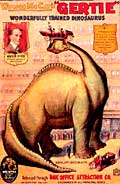 New York Herald comic-strip animator and sketch artist Winsor McCay (1869-1934) produced a string of comic strips from 1904-1911, his three best being Dreams of the Rarebit Fiend, Little Sammy Sneeze, and Little Nemo in Slumberland (from October 15, 1905 to July 23, 1911). Although McCay wasn't the first to create a cartoon animation, he nonetheless helped to define the new industry. He was the first to establish the technical method of animating graphics. His first animation attempt used the popular characters from his comic strip (and became part of his own vaudeville act): Little Nemo in Slumberland (1911) (with 4,000 hand-drawn frames), followed by How a Mosquito Operates (1912) (with 6,000 frames).
New York Herald comic-strip animator and sketch artist Winsor McCay (1869-1934) produced a string of comic strips from 1904-1911, his three best being Dreams of the Rarebit Fiend, Little Sammy Sneeze, and Little Nemo in Slumberland (from October 15, 1905 to July 23, 1911). Although McCay wasn't the first to create a cartoon animation, he nonetheless helped to define the new industry. He was the first to establish the technical method of animating graphics. His first animation attempt used the popular characters from his comic strip (and became part of his own vaudeville act): Little Nemo in Slumberland (1911) (with 4,000 hand-drawn frames), followed by How a Mosquito Operates (1912) (with 6,000 frames). 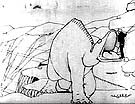 His first prominent, successful and realistic cartoon character or star was a brontosaurus named Gertie in Gertie the Dinosaur (1914) (with 10,000 drawings, backgrounds included), again presented as part of his act. In fact, McCay created the "interactive" illusion of walking into the animation by first disappearing behind the screen, reappearing on-screen!, stepping on Gertie's mouth, and then climbing onto Gertie's back for a ride - an astonishing feat! It was the earliest example of combined 'live action' and animation, and the first "interactive" animated cartoon. Some consider it the first successful, fully animated cartoon - it premiered in February 1914 at the Palace Theatre in Chicago.
His first prominent, successful and realistic cartoon character or star was a brontosaurus named Gertie in Gertie the Dinosaur (1914) (with 10,000 drawings, backgrounds included), again presented as part of his act. In fact, McCay created the "interactive" illusion of walking into the animation by first disappearing behind the screen, reappearing on-screen!, stepping on Gertie's mouth, and then climbing onto Gertie's back for a ride - an astonishing feat! It was the earliest example of combined 'live action' and animation, and the first "interactive" animated cartoon. Some consider it the first successful, fully animated cartoon - it premiered in February 1914 at the Palace Theatre in Chicago. 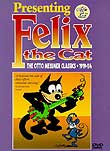 The first animated character that attained superstar status (and was anthropomorphic) during the silent era was the mischievous Felix the Cat, in Pat Sullivan Studios. He was inspired by Kipling's The Cat That Walked By Himself in the Just So Stories published in 1902.
The first animated character that attained superstar status (and was anthropomorphic) during the silent era was the mischievous Felix the Cat, in Pat Sullivan Studios. He was inspired by Kipling's The Cat That Walked By Himself in the Just So Stories published in 1902. 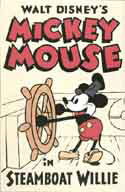 The Debut of Mickey Mouse:
The Debut of Mickey Mouse:  To help make Mickey stand out from other cartoon characters at the dawn of the talkies, the 7-minute Steamboat Willie (1928) was re-released on November 18, 1928 with sound and premiered at the 79th Street Colony Theatre in New York - it was the first cartoon with post-produced synchronized soundtrack (of music, dialogue, and sound effects) and is considered Mickey Mouse's screen debut performance and birthdate. Animated star Mickey (with Minnie) was redrawn with shoes and white, four-fingered gloves. It was a landmark film and a big hit - the first sound cartoon to be a major hit - leading to many more Mickey Mouse films during the late 1920s and 1930s. Strangely, Mickey's first sound cartoon didn't include Mickey's voice -- he didn't speak until his ninth short, The Karnival Kid (1929) when he said the words: "Hot dogs!" [Walt's voice was used for Mickey.] Walt Disney was fast becoming the most influential pioneer in the field of character-based cel animation, through his shrewd oversight of production.
To help make Mickey stand out from other cartoon characters at the dawn of the talkies, the 7-minute Steamboat Willie (1928) was re-released on November 18, 1928 with sound and premiered at the 79th Street Colony Theatre in New York - it was the first cartoon with post-produced synchronized soundtrack (of music, dialogue, and sound effects) and is considered Mickey Mouse's screen debut performance and birthdate. Animated star Mickey (with Minnie) was redrawn with shoes and white, four-fingered gloves. It was a landmark film and a big hit - the first sound cartoon to be a major hit - leading to many more Mickey Mouse films during the late 1920s and 1930s. Strangely, Mickey's first sound cartoon didn't include Mickey's voice -- he didn't speak until his ninth short, The Karnival Kid (1929) when he said the words: "Hot dogs!" [Walt's voice was used for Mickey.] Walt Disney was fast becoming the most influential pioneer in the field of character-based cel animation, through his shrewd oversight of production. 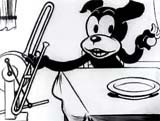 The Fleischer Brothers also made the first animated films (cartoons) that featured a soundtrack, in a series of 36 films released in the mid-1920s called Ko-Ko Song Car-Tunes (1924-1927) - the precursors to karaoke. The first sound cartoon was one of the Song Car-Tunes -- Mother Pin a Rose on Me. They were also the first audience participation films, with sing-along lyrics and a 'bouncing-ball' helper. They included Has Anybody Here Seen Kelly? (1926), When The Midnight Choo-Choo Leaves For Alabam' (1926), Comin' Tho' The Rye (1926), Margie (1926), My Old Kentucky Home (1926), Tramp, Tramp, Tramp-The Boys Are Marching (1927), By The Light Of The Silvery Moon (1927). In My Old Kentucky Home, Bimbo said to the audience: “Follow the ball and join in everybody." Twelve of the 36 short films were released in both sound and silent versions.
The Fleischer Brothers also made the first animated films (cartoons) that featured a soundtrack, in a series of 36 films released in the mid-1920s called Ko-Ko Song Car-Tunes (1924-1927) - the precursors to karaoke. The first sound cartoon was one of the Song Car-Tunes -- Mother Pin a Rose on Me. They were also the first audience participation films, with sing-along lyrics and a 'bouncing-ball' helper. They included Has Anybody Here Seen Kelly? (1926), When The Midnight Choo-Choo Leaves For Alabam' (1926), Comin' Tho' The Rye (1926), Margie (1926), My Old Kentucky Home (1926), Tramp, Tramp, Tramp-The Boys Are Marching (1927), By The Light Of The Silvery Moon (1927). In My Old Kentucky Home, Bimbo said to the audience: “Follow the ball and join in everybody." Twelve of the 36 short films were released in both sound and silent versions. 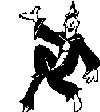 [Little-known fact: Max Fleischer was the father of Richard Fleischer, the director of Disney's 20,000 Leagues Under the Sea (1954), Fantastic Voyage (1966), Doctor Dolittle (1967) and Soylent Green (1973).]
[Little-known fact: Max Fleischer was the father of Richard Fleischer, the director of Disney's 20,000 Leagues Under the Sea (1954), Fantastic Voyage (1966), Doctor Dolittle (1967) and Soylent Green (1973).]  BimboFrom 1929-1932, their Talkartoons for Paramount starred a mouse-like character named Bimbo - who was soon relegated to a minor companion co-star with the Fleischer's next racy cartoon star.
BimboFrom 1929-1932, their Talkartoons for Paramount starred a mouse-like character named Bimbo - who was soon relegated to a minor companion co-star with the Fleischer's next racy cartoon star. 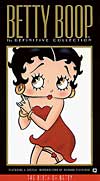 Max Fleischer was responsible for the provocative, adult-oriented, cartoon Betty Boop vamp-character, who always wore a strapless, thigh-high gown (and visible garter) and was based on flapper icon Clara Bow's 'It' Girl and Mae West. A prototype of the squeaky- and baby-voiced cartoon queen (voiced for most of the 30s by Mae Questel) was introduced in a Bimbo Talkartoon entitled Dizzy Dishes (1930) - with her appearing as a long-eared puppy dog! In the early cartoon Betty Co-Ed (1931), she was called Betty, and in a pre-Code Bimbo cartoon entitled Silly Scandals (1931) (the title spoofed Disney's Silly Symphonies), she was named Betty Boop for the first time (she sings You're Driving Me Crazy while her dress top keeps falling down). However, in Stopping the Show (1932), she appeared under her own credits banner for the first time (she had previously appeared only in Talkartoons and Screen Songs).
Max Fleischer was responsible for the provocative, adult-oriented, cartoon Betty Boop vamp-character, who always wore a strapless, thigh-high gown (and visible garter) and was based on flapper icon Clara Bow's 'It' Girl and Mae West. A prototype of the squeaky- and baby-voiced cartoon queen (voiced for most of the 30s by Mae Questel) was introduced in a Bimbo Talkartoon entitled Dizzy Dishes (1930) - with her appearing as a long-eared puppy dog! In the early cartoon Betty Co-Ed (1931), she was called Betty, and in a pre-Code Bimbo cartoon entitled Silly Scandals (1931) (the title spoofed Disney's Silly Symphonies), she was named Betty Boop for the first time (she sings You're Driving Me Crazy while her dress top keeps falling down). However, in Stopping the Show (1932), she appeared under her own credits banner for the first time (she had previously appeared only in Talkartoons and Screen Songs).  The Fleischers also obtained the rights to the tough, one-eyed, spinach-loving sailor Popeye with over-sized arms (who was introduced in January 1929 in creator Elzie C. Segar's "Thimble Theatre" newspaper comic strip published in the New York Journal for King Features Syndicate since 1919). Popeye became so popular in the comic strip that it was renamed "Thimble Theatre, Starring Popeye." Popeye first appeared on film alongside established cartoon-star Betty Boop in July, 1933 in Fleischers' Betty Boop cartoon titled Popeye the Sailor (1933), in which they dance the hula. Popeye's voice was provided by William Costello (better known as Red Pepper Sam) from 1933-35. [After Costello was dismissed, Jack Mercer, who began his career as an artist at the cartoon studio, provided Popeye's voice and ad-libbed mutterings for the Fleischers until 1957, and various voices for the two Fleischer feature-length animations - see below.] The same year in September, the first official Popeye cartoon, I Yam What I Yam was released - the first in a long series of animated shorts. Popeye's first Technicolor cartoon was the two-reel special release Popeye the Sailor Meets Sindbad the Sailor (1936), noted for its experimental multi-plane 3-D backgrounds, and for being the first Fleischer cartoon to be nominated for an Academy Award - Best Short Subject - Cartoon. The voices of Olive Oyl, Popeye's whiny girlfriend, and Sweet Pea were provided by Mae Questel. The character Wimpy provided the name for an unpopular type of British hamburger. By 1938, Popeye had replaced Mickey Mouse as the most popular cartoon character in America. Paramount's Famous Studios continued the series beginning in 1942, and Popeye's movie career lasted until 1957. Robert Altman directed the live-action film flop, Popeye (1980), starring Robin Williams as Popeye, Shelley Duvall as Olive Oyl, and Ray Walston as Pappy, Popeye's father.
The Fleischers also obtained the rights to the tough, one-eyed, spinach-loving sailor Popeye with over-sized arms (who was introduced in January 1929 in creator Elzie C. Segar's "Thimble Theatre" newspaper comic strip published in the New York Journal for King Features Syndicate since 1919). Popeye became so popular in the comic strip that it was renamed "Thimble Theatre, Starring Popeye." Popeye first appeared on film alongside established cartoon-star Betty Boop in July, 1933 in Fleischers' Betty Boop cartoon titled Popeye the Sailor (1933), in which they dance the hula. Popeye's voice was provided by William Costello (better known as Red Pepper Sam) from 1933-35. [After Costello was dismissed, Jack Mercer, who began his career as an artist at the cartoon studio, provided Popeye's voice and ad-libbed mutterings for the Fleischers until 1957, and various voices for the two Fleischer feature-length animations - see below.] The same year in September, the first official Popeye cartoon, I Yam What I Yam was released - the first in a long series of animated shorts. Popeye's first Technicolor cartoon was the two-reel special release Popeye the Sailor Meets Sindbad the Sailor (1936), noted for its experimental multi-plane 3-D backgrounds, and for being the first Fleischer cartoon to be nominated for an Academy Award - Best Short Subject - Cartoon. The voices of Olive Oyl, Popeye's whiny girlfriend, and Sweet Pea were provided by Mae Questel. The character Wimpy provided the name for an unpopular type of British hamburger. By 1938, Popeye had replaced Mickey Mouse as the most popular cartoon character in America. Paramount's Famous Studios continued the series beginning in 1942, and Popeye's movie career lasted until 1957. Robert Altman directed the live-action film flop, Popeye (1980), starring Robin Williams as Popeye, Shelley Duvall as Olive Oyl, and Ray Walston as Pappy, Popeye's father. 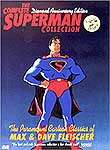 Dave and Max Fleischer, in an agreement with Paramount and DC Comics, also produced a series of seventeen Superman cartoons in the early 1940s. The first Superman short, Superman (1941), premiered in 1941, introduced the terms "faster than a speeding bullet" and "Look, up in the sky!". The most famous of the series was the second entry, The Mechanical Monsters (1941) with the super-hero battling giant flying robots - and marking a redesigned Lois Lane and the first time Superman would change into his costume in a phonebooth. Also notable was The Bulleteers (1942).
Dave and Max Fleischer, in an agreement with Paramount and DC Comics, also produced a series of seventeen Superman cartoons in the early 1940s. The first Superman short, Superman (1941), premiered in 1941, introduced the terms "faster than a speeding bullet" and "Look, up in the sky!". The most famous of the series was the second entry, The Mechanical Monsters (1941) with the super-hero battling giant flying robots - and marking a redesigned Lois Lane and the first time Superman would change into his costume in a phonebooth. Also notable was The Bulleteers (1942). 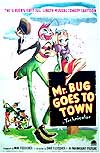 Gulliver's Travels (1939), an animated musical adaptation of Jonathan Swift's 1726 classic literary satire about war. The Fleischers, who were in direct competition with Disney, released this inferior attempt - it was the second American feature-length animated film ever, following (and patterned) after Disney's Snow White and the Seven Dwarfs (1937). The film was a two-time Academy Awards nominee: for Victor Young's Best Original Score, and for Best Song: Faithful Forever.
Gulliver's Travels (1939), an animated musical adaptation of Jonathan Swift's 1726 classic literary satire about war. The Fleischers, who were in direct competition with Disney, released this inferior attempt - it was the second American feature-length animated film ever, following (and patterned) after Disney's Snow White and the Seven Dwarfs (1937). The film was a two-time Academy Awards nominee: for Victor Young's Best Original Score, and for Best Song: Faithful Forever. 


